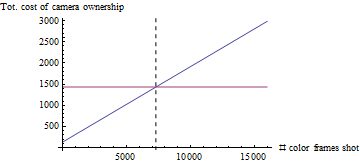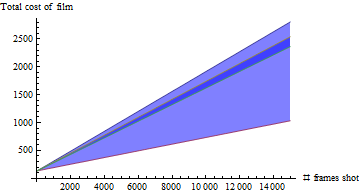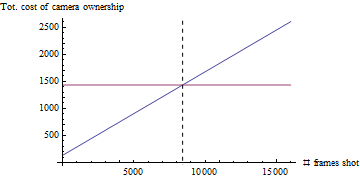Comparing film and digital camera costs
Mon, Mar 7, 2011 at 12:55AMNick and I have been bantering for the past week about which is a better medium for modern photography. While I insist that film is the way to go, Nick would rather shoot digital. Therefore, after hours of cost analysis, I have concluded that using film is cheaper than digital for the first 6.5 years.
After that long, a digital camera probably won’t be of much use since technology is changing so rapidly; the interfaces and quality of digital pictures could be improved so vastly in 6 years that one will have to purchase a new digital camera to even use it with future computers. Film cameras, on the other hand, will not change.
Here is a chart of the variable costs a photographer encounters, sans maintenance costs of the camera (like lubrication and new batteries) because those are very low-cost services and will not affect the price outcome in the long run since that cost is incurred infrequently.
The raw cost of a roll of film and a memory card was concentrated to the average cost per frame with development. Digital has no cost for taking a single color frame, while it costs nearly $0.18 for every color frame shot on film. Without a doubt, digital will always beat out film in cost. However, the cost of a film camera body is so much cheaper than a digital body, the cost of film doesn’t equalize with digital costs until thousands of frames are shot.

The blue line represents the cost of a Canon AE-1 Program SLR ($135 with a 50mm f1.8 lens) shooting with color film (includes development costs). It is represented by the equation y=x(.17814815)+135. The purple line represents a Nikon D7000 DSLR ($1200 body + $135 50mm f1.8 lens) shooting with dual 32GB SD cards (+$50 each); it is represented by the equation y=1435. The dashed black line is where the two intersect and the costs of shooting on film vs. digital are equal. To find this, we set the two equations equal to each other.
x(0.17814815)+135 = 1435
x = 7297.29 frames
Therefore, the cost of shooting on film exceeds that of digital after 7300 color frames are shot. But what does that really mean? Well, I personally shot 35 rolls of film (mixed color and B&W) in 2009 and 36 rolls in 2010. Since there are 36 exposures per roll, that means I shot, on average, 1278 pictures per year. At that rate, shooting 7300 color frames would take 5.7 years (7300/1278 = 5.712). In the first 5.7 years the digital camera would have a cost advantage over film. However, in 6 years, that digital camera’s technologies (CCD sensor, memory type) are likely to be outdated. Film cameras, on the other hand, do not change: they do not improve nor do they diminish.
But all of the above is an analysis of color photographs. In practice, B&W film is also used which decreases the total cost of film for a photographer. In my experience, I shoot between 15 and 25% of my pictures on B&W film. The chart below shows this visually.

The light-blue shaded area shows the minimum and maximum cost of shooting on film: the maximum is shooting on 100% color film while the minimum is shooting on 100% B&W film (color film is more expensive than B&W). The dark-blue shaded area is my normal operating limits: the max-dark-blue is shooting 15% B&W, while the min-dark-blue is shooting 25% B&W. Because the normal photographer will not shoot 100% color, the line tilts downward into the dark blue area due to the decrease in film cost. The film cost will decrease, on average, to $0.1545 per frame. This is found by finding the average between 0.15 and 0.25 = 0.2 and placing it into equation:
Average cost per frame = (B&W %)(Avg. B&W frame cost)+(1-B&W %)(Avg. Color frame cost)
Average cost per frame = (0.2)(.05990741)+(1-0.2)(0.17814815)
Average cost per frame = 0.1545

This change in slope moves the film-digital equilibrium point rightwards. Now, the cost of film exceeds digital when 8415 frames are shot. Still shooting at 1278 frames per year, it would take (8415/1278 = 6.58) 6.6 years. That is nearly three-fourths of a year longer than shooting 100% color film, or another 1117 frames for no additional cost.
Shooting film rather than digital is cheaper for the first 8415 frames, or about 6.6 years. After that, digital is the cheaper medium. However, when shooting digitally one carries the risk of having an obsolete camera in less than 5 years. Film, as it has proven for the past 150 years, lasts forever.